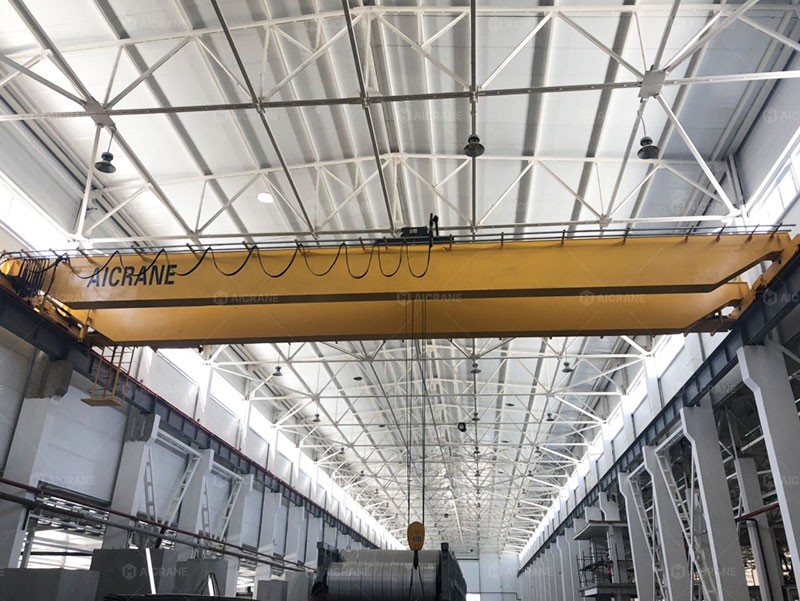Bridge cranes, also known as overhead cranes, have long been a critical component in industrial material handling. Traditionally, their cost and operation were determined by capacity, span, and duty class. However, as automation and the Internet of Things (IoT) become increasingly integrated into industrial equipment, bridge cranes are undergoing a significant transformation. These technologies are reshaping not only how cranes operate but also how their costs are structured – both upfront and over their lifecycle. Understanding these cost implications is essential for manufacturers, facility managers, and end-users who aim to invest wisely in the future of heavy lifting.

1. Upfront Costs: Automation and IoT Add Value, But at a Premium
The first noticeable impact of automation and IoT integration on bridge cranes is on capital expenditure. Adding advanced sensors, data collection systems, and automated control capabilities increases the initial investment.
Hardware Upgrades
IoT-enabled cranes require sensors for monitoring load, vibration, temperature, motor performance, and travel. Automation may also require advanced controllers, programmable logic controllers (PLCs), and motion control systems for precise positioning and operation. These additional components raise the material and hardware cost compared to traditional cranes.
Engineering and Integration
Automation and IoT integration require extensive engineering work, including system design, network setup, and software integration with facility operations. This often involves custom solutions to ensure safety, precision, and real-time monitoring. Even retrofitting existing cranes with smart features can significantly increase upfront costs.
Training and Commissioning
Installing smart and automated systems demands additional training for operators and maintenance staff. Commissioning processes are more complex because they involve testing software, verifying safety systems, and ensuring seamless integration with other facility operations. These factors contribute to higher initial expenditures.
Specification Inflation
The inclusion of automation and IoT often leads to higher specification choices. Facilities may opt for more precise control, better duty classes, or additional safety features, all of which further increase the upfront price of eot crane.

2. Operational Costs: Long-Term Savings Through Smart Technology
While automation and IoT raise initial costs, they provide substantial benefits in operational efficiency and cost reduction over time.
Reduced Labor Costs
Automated or remote controll overhead cranes reduce the need for operators, or allow a single operator to manage multiple cranes simultaneously. This shift lowers labor expenses and reallocates personnel to supervisory or maintenance roles.
Minimized Downtime
IoT-enabled monitoring allows for predictive maintenance, identifying potential issues before they lead to failures. This reduces unplanned downtime and the associated costs, which is especially valuable in high-volume or continuous production environments.
Energy Efficiency and Productivity
Automation ensures smoother crane operation with optimized movement paths, reducing energy consumption and wear on mechanical components. Real-time data from IoT systems allows facility managers to identify inefficiencies and improve crane utilization, ultimately lowering the cost per operation cycle.
Maintenance and Lifecycle Management
Continuous monitoring through IoT sensors enables early detection of wear in motors, bearings, or ropes, allowing targeted maintenance. Automation reduces human error, collisions, and misuse, extending the crane’s lifespan and reducing the cost of major repairs or component replacements.
Enhanced Safety
Automated systems often incorporate features like anti-sway control, overload detection, and collision avoidance. These technologies enhance safety, reducing accident-related costs, insurance premiums, and potential regulatory penalties.
3. Total Cost of Ownership: Balancing Upfront Investment with Long-Term Gains
When evaluating bridge crane costs, it is essential to consider the total cost of ownership (TCO), which includes both initial purchase and long-term operational costs. While IoT and automation increase upfront expenses, the long-term savings can outweigh the initial premium. Facilities with high utilization rates, demanding lifting operations, or strict safety and efficiency requirements can experience significant ROI from smart cranes.
Automation and IoT integration also enable data-driven decisions. By analyzing real-time operational data, managers can optimize crane schedules, reduce energy consumption, and plan preventive maintenance, further lowering the TCO. Over a typical lifespan of 15–25 years for industrial cranes, these operational savings can more than compensate for the initial investment.
4. Future Trends in Crane Costs
As automation and IoT technologies mature, their cost impact on bridge cranes is expected to evolve:
-
Economies of Scale: As more manufacturers adopt these technologies, hardware and software costs are likely to decrease, narrowing the price gap with traditional cranes.
-
Standardization of Features: Automation and IoT components may become standard in many crane models, reducing customization costs and simplifying procurement.
-
Data-Driven Optimization: With advanced analytics, facilities can continuously refine operations, reducing inefficiencies and extending crane lifespan.
-
Integration with Smart Facilities: Cranes integrated into smart factories or connected warehouses will operate more efficiently, further reducing labor, energy, and maintenance costs.
Conclusion
Automation and IoT integration represent a paradigm shift for bridge crane operations. While the initial investment is higher due to additional hardware, engineering, and training requirements, the long-term operational benefits – improved safety, energy efficiency, predictive maintenance, and optimized utilization – significantly reduce total lifecycle costs. For industrial facilities seeking efficiency, safety, and longevity in material handling, investing in smart bridge cranes is not just a technological upgrade – it is a strategic financial decision.
As technology continues to advance and costs of smart systems decrease, the future will likely see these features becoming standard rather than optional, transforming both the way cranes operate and the way organizations budget for heavy-lifting equipment.
